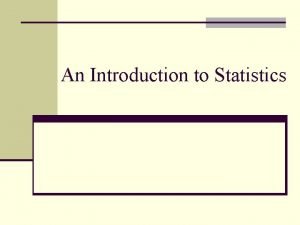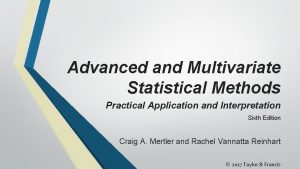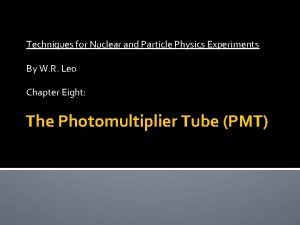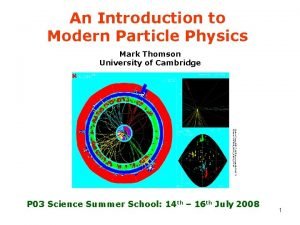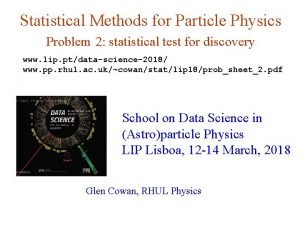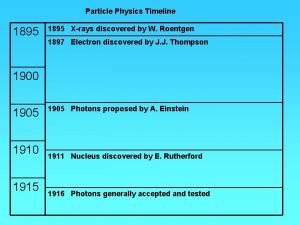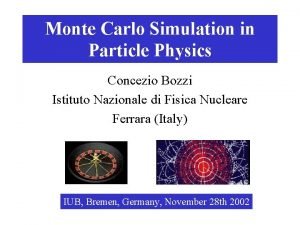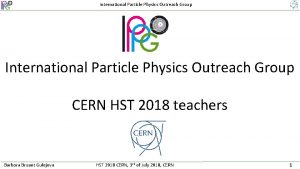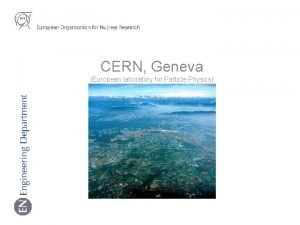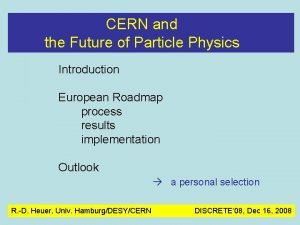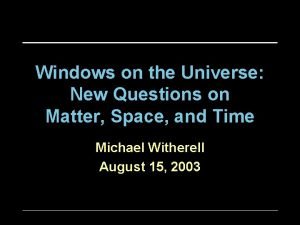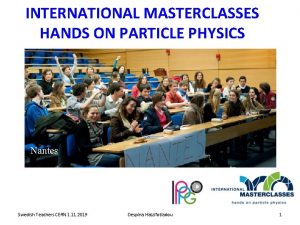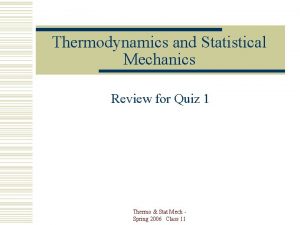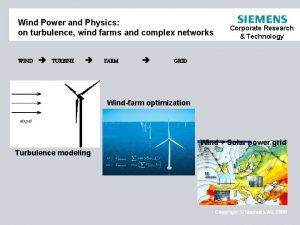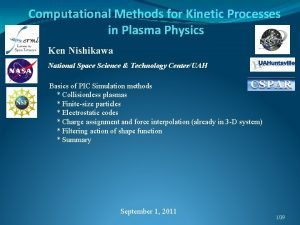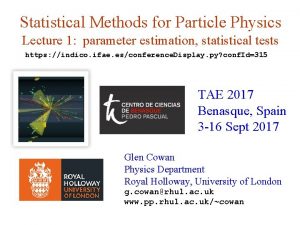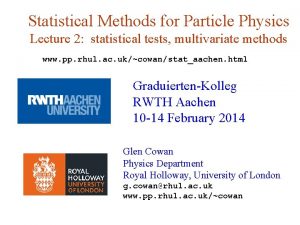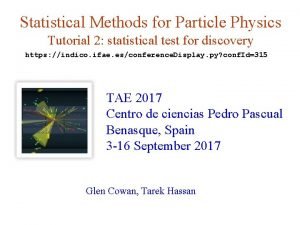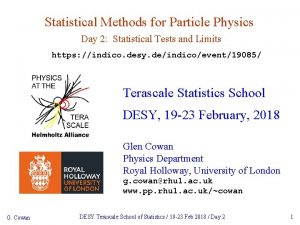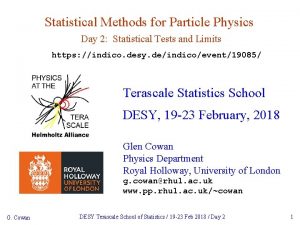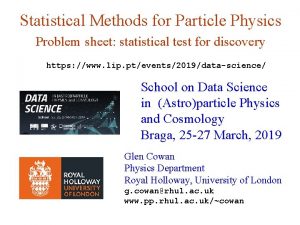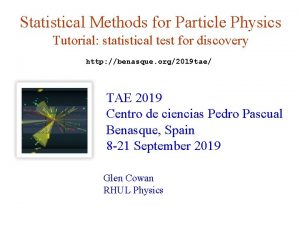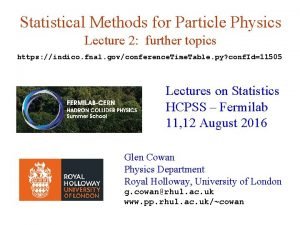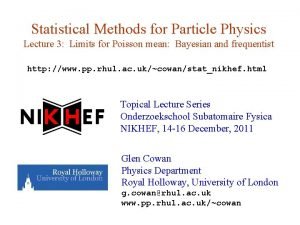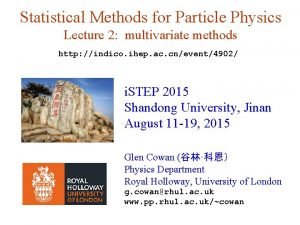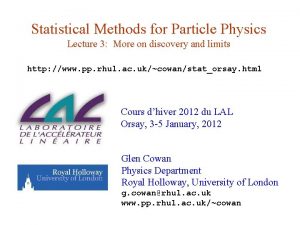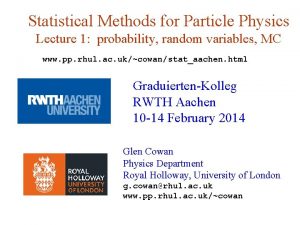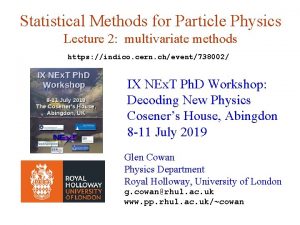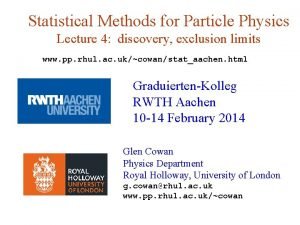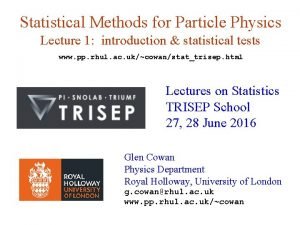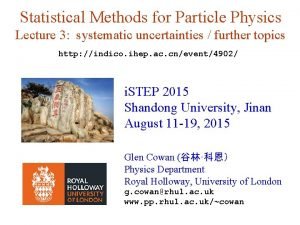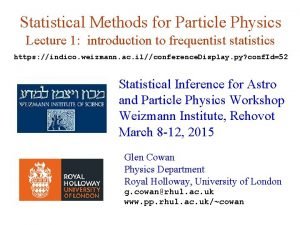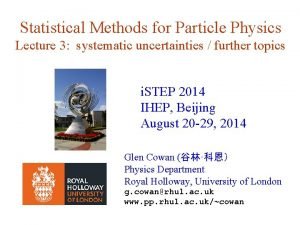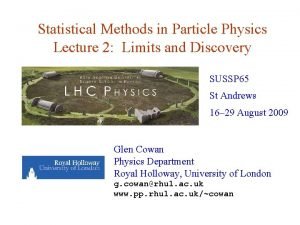Statistical Methods for Particle Physics Lecture 3 parameter






























































- Slides: 62

Statistical Methods for Particle Physics Lecture 3: parameter estimation www. pp. rhul. ac. uk/~cowan/stat_aachen. html Graduierten-Kolleg RWTH Aachen 10 -14 February 2014 Glen Cowan Physics Department Royal Holloway, University of London g. cowan@rhul. ac. uk www. pp. rhul. ac. uk/~cowan G. Cowan Aachen 2014 / Statistics for Particle Physics, Lecture 3 1

Outline 1 Probability Definition, Bayes’ theorem, probability densities and their properties, catalogue of pdfs, Monte Carlo 2 Statistical tests general concepts, test statistics, multivariate methods, goodness-of-fit tests 3 Parameter estimation general concepts, maximum likelihood, variance of estimators, least squares 4 Hypothesis tests for discovery and exclusion discovery significance, sensitivity, setting limits 5 Further topics systematic errors, Bayesian methods, MCMC G. Cowan Aachen 2014 / Statistics for Particle Physics, Lecture 3 2

Frequentist parameter estimation Suppose we have a pdf characterized by one or more parameters: random variable parameter Suppose we have a sample of observed values: We want to find some function of the data to estimate the parameter(s): ← estimator written with a hat Sometimes we say ‘estimator’ for the function of x 1, . . . , xn; ‘estimate’ for the value of the estimator with a particular data set. G. Cowan Aachen 2014 / Statistics for Particle Physics, Lecture 3 3

Properties of estimators If we were to repeat the entire measurement, the estimates from each would follow a pdf: best large variance biased We want small (or zero) bias (systematic error): → average of repeated measurements should tend to true value. And we want a small variance (statistical error): → small bias & variance are in general conflicting criteria G. Cowan Aachen 2014 / Statistics for Particle Physics, Lecture 3 4

Distribution, likelihood, model Suppose the outcome of a measurement is x. (e. g. , a number of events, a histogram, or some larger set of numbers). The probability density (or mass) function or ‘distribution’ of x, which may depend on parameters θ, is: P(x|θ) (Independent variable is x; θ is a constant. ) If we evaluate P(x|θ) with the observed data and regard it as a function of the parameter(s), then this is the likelihood: L(θ) = P(x|θ) (Data x fixed; treat L as function of θ. ) We will use the term ‘model’ to refer to the full function P(x|θ) that contains the dependence both on x and θ. G. Cowan Aachen 2014 / Statistics for Particle Physics, Lecture 3 5

Bayesian use of the term ‘likelihood’ We can write Bayes theorem as where L(x|θ) is the likelihood. It is the probability for x given θ, evaluated with the observed x, and viewed as a function of θ. Bayes’ theorem only needs L(x|θ) evaluated with a given data set (the ‘likelihood principle’). For frequentist methods, in general one needs the full model. For some approximate frequentist methods, the likelihood is enough. G. Cowan Aachen 2014 / Statistics for Particle Physics, Lecture 3 6

The likelihood function for i. i. d. *. data * i. i. d. = independent and identically distributed Consider n independent observations of x: x 1, . . . , xn, where x follows f (x; q). The joint pdf for the whole data sample is: In this case the likelihood function is (xi constant) G. Cowan Aachen 2014 / Statistics for Particle Physics, Lecture 3 7

Maximum likelihood The most important frequentist method for constructing estimators is to take the value of the parameter(s) that maximize the likelihood: The resulting estimators are functions of the data and thus characterized by a sampling distribution with a given (co)variance: In general they may have a nonzero bias: Under conditions usually satisfied in practice, bias of ML estimators is zero in the large sample limit, and the variance is as small as possible for unbiased estimators. ML estimator may not in some cases be regarded as the optimal trade-off between these criteria (cf. regularized unfolding). G. Cowan Aachen 2014 / Statistics for Particle Physics, Lecture 3 8

ML example: parameter of exponential pdf Consider exponential pdf, and suppose we have i. i. d. data, The likelihood function is The value of t for which L(t) is maximum also gives the maximum value of its logarithm (the log-likelihood function): G. Cowan Aachen 2014 / Statistics for Particle Physics, Lecture 3 9

ML example: parameter of exponential pdf (2) Find its maximum by setting → Monte Carlo test: generate 50 values using t = 1: We find the ML estimate: G. Cowan Aachen 2014 / Statistics for Particle Physics, Lecture 3 10

Variance of estimators: Monte Carlo method Having estimated our parameter we now need to report its ‘statistical error’, i. e. , how widely distributed would estimates be if we were to repeat the entire measurement many times. One way to do this would be to simulate the entire experiment many times with a Monte Carlo program (use ML estimate for MC). For exponential example, from sample variance of estimates we find: Note distribution of estimates is roughly Gaussian − (almost) always true for ML in large sample limit. G. Cowan Aachen 2014 / Statistics for Particle Physics, Lecture 3 11

Variance of estimators from information inequality The information inequality (RCF) sets a lower bound on the variance of any estimator (not only ML): Minimum Variance Bound (MVB) Often the bias b is small, and equality either holds exactly or is a good approximation (e. g. large data sample limit). Then, Estimate this using the 2 nd derivative of ln L at its maximum: G. Cowan Aachen 2014 / Statistics for Particle Physics, Lecture 3 12

Variance of estimators: graphical method Expand ln L (q) about its maximum: First term is ln Lmax, second term is zero, for third term use information inequality (assume equality): i. e. , → to get G. Cowan , change q away from until ln L decreases by 1/2. Aachen 2014 / Statistics for Particle Physics, Lecture 3 13

Example of variance by graphical method ML example with exponential: Not quite parabolic ln L since finite sample size (n = 50). G. Cowan Aachen 2014 / Statistics for Particle Physics, Lecture 3 14

Functions of ML estimators Suppose we had written the exponential pdf as i. e. , we use l = 1/t. What is the ML estimator for l? Rewrite the likelihood replacing τ by 1/λ. The λ that maximizes L(λ) is the λ that corresponds to the τ that maximizes L(τ), i. e. , So for the decay constant we have Caveat: is biased, even though Can show G. Cowan is unbiased. (bias → 0 for n →∞) Aachen 2014 / Statistics for Particle Physics, Lecture 3 15

Information inequality for n parameters Suppose we have estimated n parameters The (inverse) minimum variance bound is given by the Fisher information matrix: The information inequality then states that V - I-1 is a positive semi-definite matrix, where Therefore Often use I-1 as an approximation for covariance matrix, estimate using e. g. matrix of 2 nd derivatives at maximum of L. G. Cowan Aachen 2014 / Statistics for Particle Physics, Lecture 3 16

Two-parameter example of ML Consider a scattering angle distribution with x = cos q, Data: x 1, . . . , xn, n = 2000 events. As test generate with MC using a = 0. 5, b = 0. 5 From data compute log-likelihood: Maximize numerically (e. g. , program MINUIT) G. Cowan Aachen 2014 / Statistics for Particle Physics, Lecture 3 17

Example of ML: fit result Finding maximum of ln L(a, b) numerically (MINUIT) gives N. B. Here no binning of data for fit, but can compare to histogram for goodness-of-fit (e. g. ‘visual’ or c 2). (Co)variances from G. Cowan Aachen 2014 / Statistics for Particle Physics, Lecture 3 (MINUIT routine HESSE) 18

Variance of ML estimators: graphical method Often (e. g. , large sample case) one can approximate the covariances using only the likelihood L(θ): This translates into a simple graphical recipe: ML fit result → Tangent lines to contours give standard deviations. → Angle of ellipse f related to correlation: G. Cowan Aachen 2014 / Statistics for Particle Physics, Lecture 3 19

Variance of ML estimators: MC To find the ML estimate itself one only needs the likelihood L(θ). In principle to find the covariance of the estimators, one requires the full model L(x|θ). E. g. , simulate many times independent data sets and look at distribution of the resulting estimates: G. Cowan Aachen 2014 / Statistics for Particle Physics, Lecture 3 20

Extended ML Sometimes regard n not as fixed, but as a Poisson r. v. , mean n. Result of experiment defined as: n, x 1, . . . , xn. The (extended) likelihood function is: Suppose theory gives n = n(q), then the log-likelihood is where C represents terms not depending on q. G. Cowan Aachen 2014 / Statistics for Particle Physics, Lecture 3 21

Extended ML (2) Example: expected number of events where the total cross section s(q) is predicted as a function of the parameters of a theory, as is the distribution of a variable x. Extended ML uses more info → smaller errors for Important e. g. for anomalous couplings in e+e- → W+WIf n does not depend on q but remains a free parameter, extended ML gives: G. Cowan Aachen 2014 / Statistics for Particle Physics, Lecture 3 22

Extended ML example Consider two types of events (e. g. , signal and background) each of which predict a given pdf for the variable x: fs(x) and fb(x). We observe a mixture of the two event types, signal fraction = q, expected total number = n, observed total number = n. Let goal is to estimate ms, mb. → G. Cowan Aachen 2014 / Statistics for Particle Physics, Lecture 3 23

Extended ML example (2) Monte Carlo example with combination of exponential and Gaussian: Maximize log-likelihood in terms of ms and mb: Here errors reflect total Poisson fluctuation as well as that in proportion of signal/background. G. Cowan Aachen 2014 / Statistics for Particle Physics, Lecture 3 24

ML with binned data Often put data into a histogram: Hypothesis is where If we model the data as multinomial (ntot constant), then the log-likelihood function is: G. Cowan Aachen 2014 / Statistics for Particle Physics, Lecture 3 25

ML example with binned data Previous example with exponential, now put data into histogram: Limit of zero bin width → usual unbinned ML. If ni treated as Poisson, we get extended log-likelihood: G. Cowan Aachen 2014 / Statistics for Particle Physics, Lecture 3 26

Relationship between ML and Bayesian estimators In Bayesian statistics, both q and x are random variables: Recall the Bayesian method: Use subjective probability for hypotheses (q); before experiment, knowledge summarized by prior pdf p(q); use Bayes’ theorem to update prior in light of data: Posterior pdf (conditional pdf for q given x) G. Cowan Aachen 2014 / Statistics for Particle Physics, Lecture 3 27

ML and Bayesian estimators (2) Purist Bayesian: p(q | x) contains all knowledge about q. Pragmatist Bayesian: p(q | x) could be a complicated function, → summarize using an estimator Take mode of p(q | x) , (could also use e. g. expectation value) What do we use for p(q)? No golden rule (subjective!), often represent ‘prior ignorance’ by p(q) = constant, in which case But. . . we could have used a different parameter, e. g. , l = 1/q, and if prior pq(q) is constant, then pl(l) is not! ‘Complete prior ignorance’ is not well defined. G. Cowan Aachen 2014 / Statistics for Particle Physics, Lecture 3 28

The method of least squares Suppose we measure N values, y 1, . . . , y. N, assumed to be independent Gaussian r. v. s with Assume known values of the control variable x 1, . . . , x. N and known variances We want to estimate θ , i. e. , fit the curve to the data points. The likelihood function is G. Cowan Aachen 2014 / Statistics for Particle Physics, Lecture 3 29

The method of least squares (2) The log-likelihood function is therefore So maximizing the likelihood is equivalent to minimizing Minimum defines the least squares (LS) estimator Very often measurement errors are ~Gaussian and so ML and LS are essentially the same. Often minimize χ 2 numerically (e. g. program MINUIT). G. Cowan Aachen 2014 / Statistics for Particle Physics, Lecture 3 30

LS with correlated measurements If the yi follow a multivariate Gaussian, covariance matrix V, Then maximizing the likelihood is equivalent to minimizing G. Cowan Aachen 2014 / Statistics for Particle Physics, Lecture 3 31

Example of least squares fit Fit a polynomial of order p: G. Cowan Aachen 2014 / Statistics for Particle Physics, Lecture 3 32

Variance of LS estimators In most cases of interest we obtain the variance in a manner similar to ML. E. g. for data ~ Gaussian we have and so 1. 0 or for the graphical method we take the values of θ where G. Cowan Aachen 2014 / Statistics for Particle Physics, Lecture 3 33

Two-parameter LS fit G. Cowan Aachen 2014 / Statistics for Particle Physics, Lecture 3 34

Goodness-of-fit with least squares The value of the χ 2 at its minimum is a measure of the level of agreement between the data and fitted curve: It can therefore be employed as a goodness-of-fit statistic to test the hypothesized functional form λ (x; θ ). We can show that if the hypothesis is correct, then the statistic t = χ 2 min follows the chi-square pdf, where the number of degrees of freedom is nd = number of data points - number of fitted parameters G. Cowan Aachen 2014 / Statistics for Particle Physics, Lecture 3 35

Goodness-of-fit with least squares (2) The chi-square pdf has an expectation value equal to the number of degrees of freedom, so if χ 2 min ≈ nd the fit is ‘good’. More generally, find the p-value: This is the probability of obtaining a χ 2 min as high as the one we got, or higher, if the hypothesis is correct. E. g. for the previous example with 1 st order polynomial (line), whereas for the 0 th order polynomial (horizontal line), G. Cowan Aachen 2014 / Statistics for Particle Physics, Lecture 3 36

Goodness-of-fit vs. statistical errors G. Cowan Aachen 2014 / Statistics for Particle Physics, Lecture 3 37

Goodness-of-fit vs. stat. errors (2) G. Cowan Aachen 2014 / Statistics for Particle Physics, Lecture 3 38

LS with binned data G. Cowan Aachen 2014 / Statistics for Particle Physics, Lecture 3 39

LS with binned data (2) G. Cowan Aachen 2014 / Statistics for Particle Physics, Lecture 3 40

LS with binned data — normalization G. Cowan Aachen 2014 / Statistics for Particle Physics, Lecture 3 41

LS normalization example G. Cowan Aachen 2014 / Statistics for Particle Physics, Lecture 3 42

Goodness of fit from the likelihood ratio Suppose we model data using a likelihood L(μ) that depends on N parameters μ = (μ 1, . . . , μΝ). Define the statistic Value of tμ reflects agreement between hypothesized μ and the data. � ≈ μ, so t is small; Good agreement means μ μ Larger tμ means less compatibility between data and μ. Quantify “goodness of fit” with p-value: G. Cowan Aachen 2014 / Statistics for Particle Physics, Lecture 3 43

Likelihood ratio (2) Now suppose the parameters μ = (μ 1, . . . , μΝ) can be determined by another set of parameters θ = (θ 1, . . . , θM), with M < N. E. g. in LS fit, use μi = μ(xi; θ) where x is a control variable. Define the statistic fit M parameters fit N parameters Use qμ to test hypothesized functional form of μ(x; θ). To get p-value, need pdf f(qμ|μ). G. Cowan Aachen 2014 / Statistics for Particle Physics, Lecture 3 44

Wilks’ Theorem (1938) Wilks’ Theorem: if the hypothesized parameters μ = (μ 1, . . . , μΝ) are true then in the large sample limit (and provided certain conditions are satisfied) tμ and qμ follow chi-square distributions. For case with μ = (μ 1, . . . , μΝ) fixed in numerator: Or if M parameters adjusted in numerator, G. Cowan Aachen 2014 / Statistics for Particle Physics, Lecture 3 degrees of freedom 45

Goodness of fit with Gaussian data Suppose the data are N independent Gaussian distributed values: want to estimate known Likelihood: Log-likelihood: ML estimators: G. Cowan Aachen 2014 / Statistics for Particle Physics, Lecture 3 46

Likelihood ratios for Gaussian data The goodness-of-fit statistics become So Wilks’ theorem formally states the well-known property of the minimized chi-squared from an LS fit. G. Cowan Aachen 2014 / Statistics for Particle Physics, Lecture 3 47

Likelihood ratio for Poisson data Suppose the data are a set of values n = (n 1, . . . , nΝ), e. g. , the numbers of events in a histogram with N bins. Assume ni ~ Poisson(νi), i = 1, . . . , N, all independent. Goal is to estimate ν = (ν 1, . . . , νΝ). Likelihood: Log-likelihood: ML estimators: G. Cowan Aachen 2014 / Statistics for Particle Physics, Lecture 3 48

Goodness of fit with Poisson data The likelihood ratio statistic (all parameters fixed in numerator): Wilks’ theorem: G. Cowan Aachen 2014 / Statistics for Particle Physics, Lecture 3 49

Goodness of fit with Poisson data (2) Or with M fitted parameters in numerator: Wilks’ theorem: Use tμ, qμ to quantify goodness of fit (p-value). Sampling distribution from Wilks’ theorem (chi-square). Exact in large sample limit; in practice good approximation for surprisingly small ni (~several). G. Cowan Aachen 2014 / Statistics for Particle Physics, Lecture 3 50

Goodness of fit with multinomial data Similar if data n = (n 1, . . . , nΝ) follow multinomial distribution: E. g. histogram with N bins but fix: Log-likelihood: ML estimators: G. Cowan (Only N-1 independent; one is ntot minus sum of rest. ) Aachen 2014 / Statistics for Particle Physics, Lecture 3 51

Goodness of fit with multinomial data (2) The likelihood ratio statistics become: One less degree of freedom than in Poisson case because effectively only N-1 parameters fitted in denominator. G. Cowan Aachen 2014 / Statistics for Particle Physics, Lecture 3 52

Estimators and g. o. f. all at once Evaluate numerators with θ (not its estimator): (Poisson) (Multinomial) These are equal to the corresponding -2 ln L(θ) plus terms not depending on θ, so minimizing them gives the usual ML estimators for θ. The minimized value gives the statistic qμ, so we get goodness-of-fit for free. G. Cowan Aachen 2014 / Statistics for Particle Physics, Lecture 3 53

Using LS to combine measurements G. Cowan Aachen 2014 / Statistics for Particle Physics, Lecture 3 54

Combining correlated measurements with LS G. Cowan Aachen 2014 / Statistics for Particle Physics, Lecture 3 55

Example: averaging two correlated measurements G. Cowan Aachen 2014 / Statistics for Particle Physics, Lecture 3 56

Negative weights in LS average G. Cowan Aachen 2014 / Statistics for Particle Physics, Lecture 3 57

Extra slides G. Cowan Aachen 2014 / Statistics for Particle Physics, Lecture 3 58

Example of ML: parameters of Gaussian pdf Consider independent x 1, . . . , xn, with xi ~ Gaussian (m, s 2) The log-likelihood function is G. Cowan Aachen 2014 / Statistics for Particle Physics, Lecture 3 59

Example of ML: parameters of Gaussian pdf (2) Set derivatives with respect to m, s 2 to zero and solve, We already know that the estimator for m is unbiased. But we find, however, so ML estimator for s 2 has a bias, but b→ 0 for n→∞. Recall, however, that is an unbiased estimator for s 2. G. Cowan Aachen 2014 / Statistics for Particle Physics, Lecture 3 60

Extended ML example: an unphysical estimate A downwards fluctuation of data in the peak region can lead to even fewer events than what would be obtained from background alone. Estimate for ms here pushed negative (unphysical). We can let this happen as long as the (total) pdf stays positive everywhere. G. Cowan Aachen 2014 / Statistics for Particle Physics, Lecture 3 61

Unphysical estimators (2) Here the unphysical estimator is unbiased and should nevertheless be reported, since average of a large number of unbiased estimates converges to the true value (cf. PDG). Repeat entire MC experiment many times, allow unphysical estimates: G. Cowan Aachen 2014 / Statistics for Particle Physics, Lecture 3 62
 01:640:244 lecture notes - lecture 15: plat, idah, farad
01:640:244 lecture notes - lecture 15: plat, idah, farad Statistical methods of demand forecasting
Statistical methods of demand forecasting Statistical methods of demand forecasting
Statistical methods of demand forecasting The two branches of statistics
The two branches of statistics Advanced and multivariate statistical methods
Advanced and multivariate statistical methods Pmt particle physics
Pmt particle physics Mark thomson modern particle physics
Mark thomson modern particle physics Particle physics
Particle physics Particle physics practice quiz
Particle physics practice quiz Particle physics timeline
Particle physics timeline Concezio bozzi
Concezio bozzi Cern particle physics
Cern particle physics European laboratory for particle physics
European laboratory for particle physics Cern particle physics
Cern particle physics Particle physics
Particle physics Form factor particle physics
Form factor particle physics International masterclasses hands on particle physics
International masterclasses hands on particle physics Statistical physics quiz
Statistical physics quiz Statistical physics
Statistical physics Https://slidetodoc.com
Https://slidetodoc.com Physics 111 lecture notes
Physics 111 lecture notes Physics 101 lecture notes pdf
Physics 101 lecture notes pdf Physics 101 lecture 1
Physics 101 lecture 1 Physics 101 lecture notes pdf
Physics 101 lecture notes pdf Waves physics notes pdf
Waves physics notes pdf Atmospheric physics lecture notes
Atmospheric physics lecture notes A-wax pattern recognition
A-wax pattern recognition Computational methods in plasma physics
Computational methods in plasma physics Why does it happen
Why does it happen University physics with modern physics fifteenth edition
University physics with modern physics fifteenth edition Physics ia
Physics ia Fspos vägledning för kontinuitetshantering
Fspos vägledning för kontinuitetshantering Typiska drag för en novell
Typiska drag för en novell Nationell inriktning för artificiell intelligens
Nationell inriktning för artificiell intelligens Ekologiskt fotavtryck
Ekologiskt fotavtryck Varför kallas perioden 1918-1939 för mellankrigstiden
Varför kallas perioden 1918-1939 för mellankrigstiden En lathund för arbete med kontinuitetshantering
En lathund för arbete med kontinuitetshantering Underlag för särskild löneskatt på pensionskostnader
Underlag för särskild löneskatt på pensionskostnader Tidbok
Tidbok A gastrica
A gastrica Densitet vatten
Densitet vatten Datorkunskap för nybörjare
Datorkunskap för nybörjare Boverket ka
Boverket ka Tes debattartikel
Tes debattartikel Magnetsjukhus
Magnetsjukhus Nyckelkompetenser för livslångt lärande
Nyckelkompetenser för livslångt lärande Påbyggnader för flakfordon
Påbyggnader för flakfordon Vätsketryck formel
Vätsketryck formel Publik sektor
Publik sektor Kyssande vind analys
Kyssande vind analys Presentera för publik crossboss
Presentera för publik crossboss Teckenspråk minoritetsspråk argument
Teckenspråk minoritetsspråk argument Kanaans land
Kanaans land Klassificeringsstruktur för kommunala verksamheter
Klassificeringsstruktur för kommunala verksamheter Luftstrupen för medicinare
Luftstrupen för medicinare Bästa kameran för astrofoto
Bästa kameran för astrofoto Cks
Cks Byggprocessen steg för steg
Byggprocessen steg för steg Bra mat för unga idrottare
Bra mat för unga idrottare Verktyg för automatisering av utbetalningar
Verktyg för automatisering av utbetalningar Rutin för avvikelsehantering
Rutin för avvikelsehantering Smärtskolan kunskap för livet
Smärtskolan kunskap för livet Ministerstyre för och nackdelar
Ministerstyre för och nackdelar



